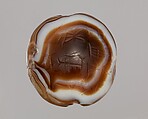Bead with cuneiform inscription of Kurigalzu I or II
Not on view
Eye-like beads and stones, made from naturally occurring agate formations, are found throughout Mesopotamian history. At least by the end of the third millennium B.C., rulers began carving short inscriptions on these stones, dedicating them to the gods. Some eyestones, like this example, are drilled through the side with a hole allowing the beads to be strung, perhaps as part of jewelry. Whatever the use of these stones, as elements of jewelry or otherwise, it is clear that their eye-like appearance was an important and potent part of their meaning. The inscribed eyestones, some of which were dedicated “for the life” of the individual, seem to evoke the desire to be looked upon with favor by the gods. The beneficent gaze of the gods was especially important to kings, who depended on divine favor for a successful and long-lasting reign. Indeed, of all the examples of inscribed eyestones known throughout Mesopotamian history, the vast majority bear royal names.
This example, dated by its inscription to the Kassite period (ca. 1595-1155 B.C.), was dedicated to the goddess Ninlil, wife of the chief god Enlil, by king Kurigalzu (I or II). The inscription, written on the face of the stone across the dark, pupil-like center, can only be seen from close up. Currently, more inscribed eyestones are known from the Kassite period than any other. The Kassite desire for these stone “eyes” seems to have exceeded available supplies and spawned a search for alternatives, including imperfectly circular examples such as this banded agate bead. Faience imitations were also used as acceptable substitutes.
Due to rights restrictions, this image cannot be enlarged, viewed at full screen, or downloaded.

